What is the XML sitemap?
XML Sitemap is a file that lists all your website content in XML format, so search engines like Google can easily find and index your content.
Back in the early 2000s, the government websites was used to have a link on their main page, titled “Sitemap”. This page usually lists all pages on the website.
While some websites still have html sites today, the overall use of sitemap has evolved.
Today Sitemaps is published in the XML format instead of HTML, and their target audience is a search engine and not people.
Basically, the XML sitemap is a way for website owners to tell search engines about all the pages on their website.
It also tells search engines that links on your website are more important than others, and how often you update your website.
While the XML map will not increase the ranking of your search engine, they allow search engines to better crawl your website. This means they can find more content and start showing in search results so that it produces more search traffic, and an increase in SEO rankings.
Why do you need an XML sitemap?
Sitemaps are very important from the point of view of search engine optimization (SEO).
Just add the sitemap to not affect search rankings. However, if there is a page on your site that is not indexed, then the sitemap gives you a way to let the search engine know about that page.
Sitemaps is very useful for when you first start a blog or create a new website because most new websites don’t have backlinks. This makes it more difficult for search engines to find all their content.
This is why search engines like Google and Bing allow new website owners to send sitemaps on their webmaster tools. This allows their search engine bots to easily find and index your content (more about this later).
Sitemaps are just as important for established popular websites. They allow you to highlight which parts of your website are more important, which parts are more frequently updated, etc., so search engines can visit and index your content accordingly.
That is saying, let’s see how to make a xml sitemap on WordPress.
How do you make a sitemap on WordPress?
There are several ways to make XML sitemaps on WordPress. I will show you three most popular methods to make XML sitemaps on WordPress, and you can be select best method suits .
- How to Make a XML Sitemap on WordPress without a plugin
- Make the XML sitemap on WordPress using all in one SEO
- Make a XML sitemap on WordPress using SEO Yoast
Method 1. How to Make a XML Sitemap on WordPress without a plugin
This method is very basic and limited in terms of features.
Until August 2020, WordPress did not have a default sitemap. But in WordPress 5.5, they released a basic XML sitemap feature.
This allows you to automatically create XML sitemaps on WordPress without using plugins. You just add wp-sitemap.xml at the end of your domain name, and WordPress will show you the default XML site map.
This XML sitemap feature is added to WordPress to ensure that the new WordPress website does not miss the SEO benefits of the XML sitemap.
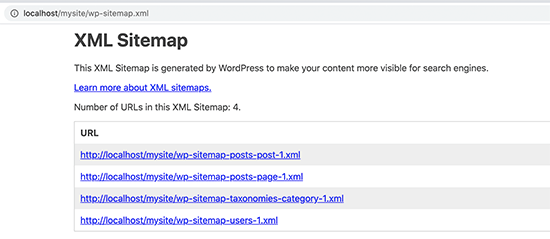
However, it’s not too flexible, and you can’t easily control what will be added or removed from your XML map map.
Fortunately, almost all Seo WordPress top plugins are equipped with their own sitemap function. This map-sitemap is better, and you can control which content will be deleted or excluded from your WordPress XML sitemaps.
Method 2. Make the XML sitemap on WordPress using all in one SEO
The easiest way to make an XML sitemap on WordPress is to use the All In One SEO plugin for WordPress.
This is the best WordPress SEO plugin on the market that offers you a set of comprehensive tools to optimize your blog posts for SEO.
First, you need to install and activate all SEO all in one plugins. For more details, see our step-by-step guide on how to install the WordPress plugin.
Note: Sitemap features are also available in the free version of AIOSEO. But to get sophisticated news sitemap and video map video, you will need a pro version.
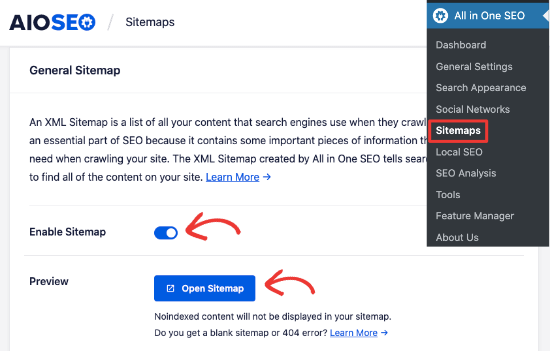
After activation, open the SEO All in One sitemaps page »to review the sitemap settings.
By default, All in One SEO plugin will activate the sitemap feature for you and replace the basic WordPress sitemaps.
You can click the ‘Open Sitemap’ button to see it to see what it looks like. You can also view your site map by adding ‘sitemap.xml’ to the URL like www.meostargraphix.com/sitemap.xml.

As a beginner, you don’t need to do anything because the default settings will function for all types of websites, blogs and online stores.
However, you can adjust the sitemap settings to control what you want to include in your XML sitemap.
Simply scroll down to the site map settings section.
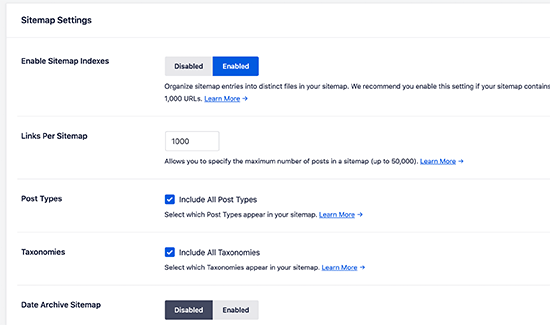
This section gives you the option to manage the Sitemap Index, including or exclude the type of post, taxonomy (categories and tags). You can also activate the XML map map for date-based archives and writer archives.
All in one SEO automatically includes all your WordPress content on the XML site map. However, what if you have a stand-alone page like a contact form, landing page, or shop for Shopify store which is not part of WordPress?
Well, AIOSEO is the only plugin that lets you add an external page in your WordPress sitemap. Simply scroll to the additional page section and turn it on. This will show you the form where you can add a special page you want to include.

You only need to add the page url you want to include and then set the priority where 0.0 is the lowest and 1.0 is the highest, if you are not sure then we recommend using 0.3.
Next, select the last modified frequency and date for the page.
You can click the ‘Add new’ button if you need to add more pages.
Please must click the ‘Save Change’ button to save your settings.
Not including posts / special pages of your XML sitemap
All in one SEO allows you to exclude posts or pages from your XML site map. You can do this by clicking on the advanced settings under the SEO All in One sitemap page>
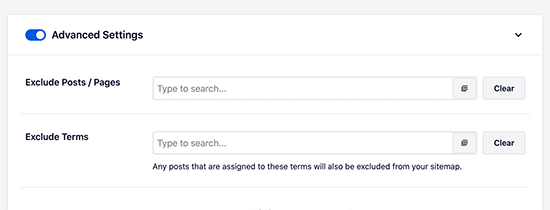
You can also delete posts or pages from your XML map, map by making it no index and without participating. This will block search engines so as not to show content in search results.
Only edit the post or page that you want to exclude and scroll down to the AIOSEO setting box below the editor.
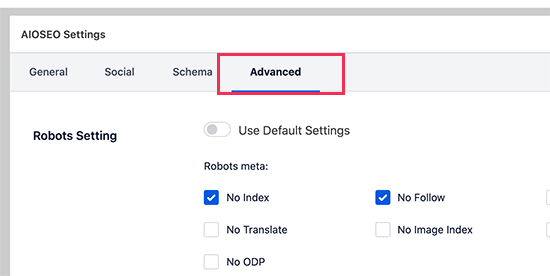
From here you need to switch to the Advanced tab and check the box next to ‘without index’ and ‘don’t follow’.
Make additional sitemaps
All in one SEO allows you to create additional site maps such as video sites or news sitemap.
Method 3. Make a xml sitemap on WordPress using SEO Yoast
If you are using Yoast SEO plugin as your WordPress SEO plugin, then it also automatically turns on the XML map for you.
First, you need to install and activate the SEO Yoast plugin. For more details, see our step-by-step guide on how to install the WordPress plugin.
After activation, open SEO »General pages and switch to the ‘Feature’ tab. From here, you need to scroll down to the ‘XML sitemap’ option and make sure it is turned on.
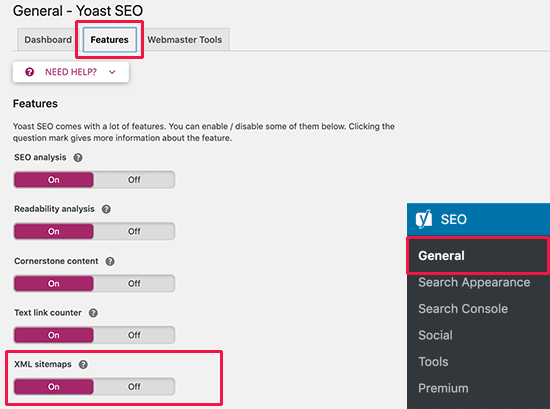
Next, click the Save Change button to save your changes.
To verify that Yoast SEO has made a XML sitemap, you can click the question mark icon next to the XML site map option on the page.
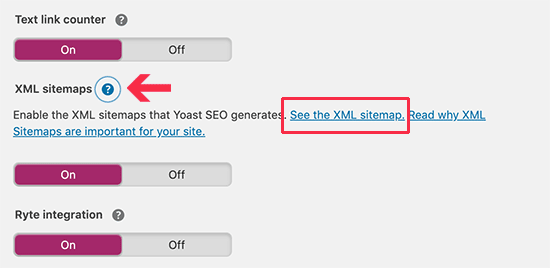
After that, click the ‘View XML Sitemap’ link to view your direct XML site map produced by Yoast SEO.
You can also find your XML site map just by adding sitemap_index.xml at the end of your website address. As an example:
https://www.example.com/sitemap_index.xml.

Yoast SEO creates several map maps for various types of content. By default, it will produce a site map for posts, pages, writers, and categories.
How to send your XML site map to a search engine
Search engines are smart enough to find a sitemap. Every time you publish new content, ping is sent to Google and Bing to tell them about changes in your sitemap.
However, we suggest you send a sitemap manually to ensure that search engines can find it.
Send your XML sitemap to Google
Google Search Console is a free tool offered by Google to help website owners monitor and maintain the presence of their site in Google search results.
Adding your sitemap to Google Search Console helps quickly find your content even if your website is new.
First, you need to visit the Google Search Console website and register an account.
After that, you will be asked to choose the property type. You can choose a domain or the URL prefix. We suggest choosing the URL prefix because it is easier to set.
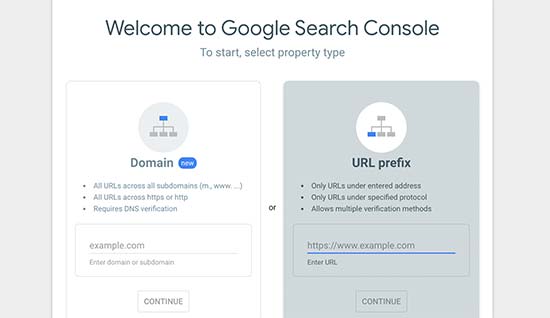
Enter the URL of your website and then click the Continue button.
Next, you will be asked to verify the ownership of the website. You will see several methods to do that, we recommend using the HTML tag method.
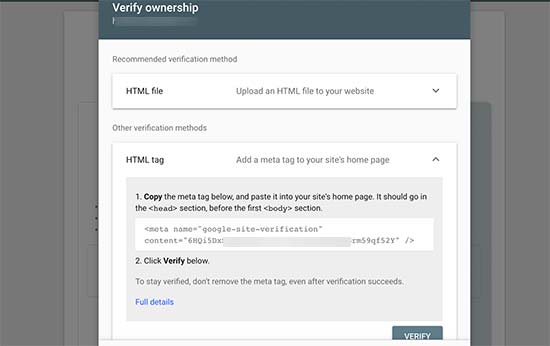
Simply copy the code on the screen and then go to your WordPress website admin area.
If you use AIOSEO, then it comes with a verification of an easy webmaster tool. Just open all in one SEO »General settings and then click the Webmaster Tool tab. After that, you can enter the code from Google there.
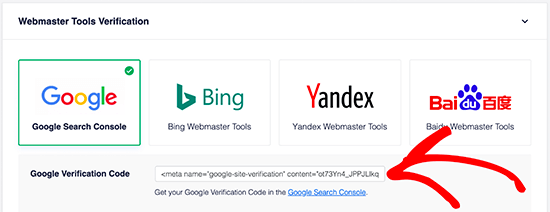
If you don’t use AIOSEO, then you need to install and activate the Header and Footer plugin. For more details, see our step-by-step guide on how to install the WordPress plugin.
After plugin activation, you need to go to settings tab, Enter the Header and Footer Page and add the code you copy before in the ‘Script in Header’ box.
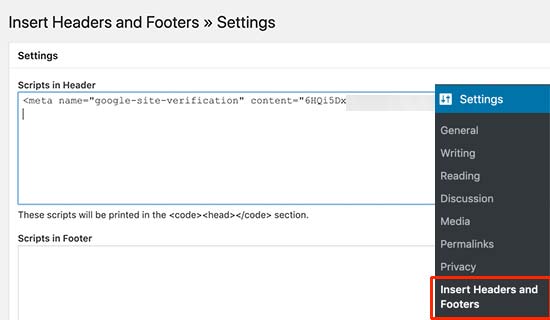
Hit the Save button to save your changes.
Now, switch back to the Google Console search tab and click the ‘Verification’ button.
Google will check the verification code on your site and then add it to your Google Search Console account.
Note: If the verification is not successful, then make sure to remove your cache and then try again.
Now after you add your website, let’s add your XML site map too.

From the dashboard your account, you need to click on ‘sitemaps’ from the left column.
After that, you need to add the last part of your Sitemap URL under the ‘Add New Site Site’ section and click the Send button.
Google will now add your Sitemap URL to your Google search console.
It will take Google some time to crawl your website. After a while, you will be able to see basic sitemap statistics.
This information includes the number of links found by Google in your sitemap, how many of them are indexed, the ratio of images to web pages, and more.









